Lotus Eletre S review: a stunning electric SUV with sporting heritage
This big four-door EV might not be what you expect from a Lotus but it’s just as impressive
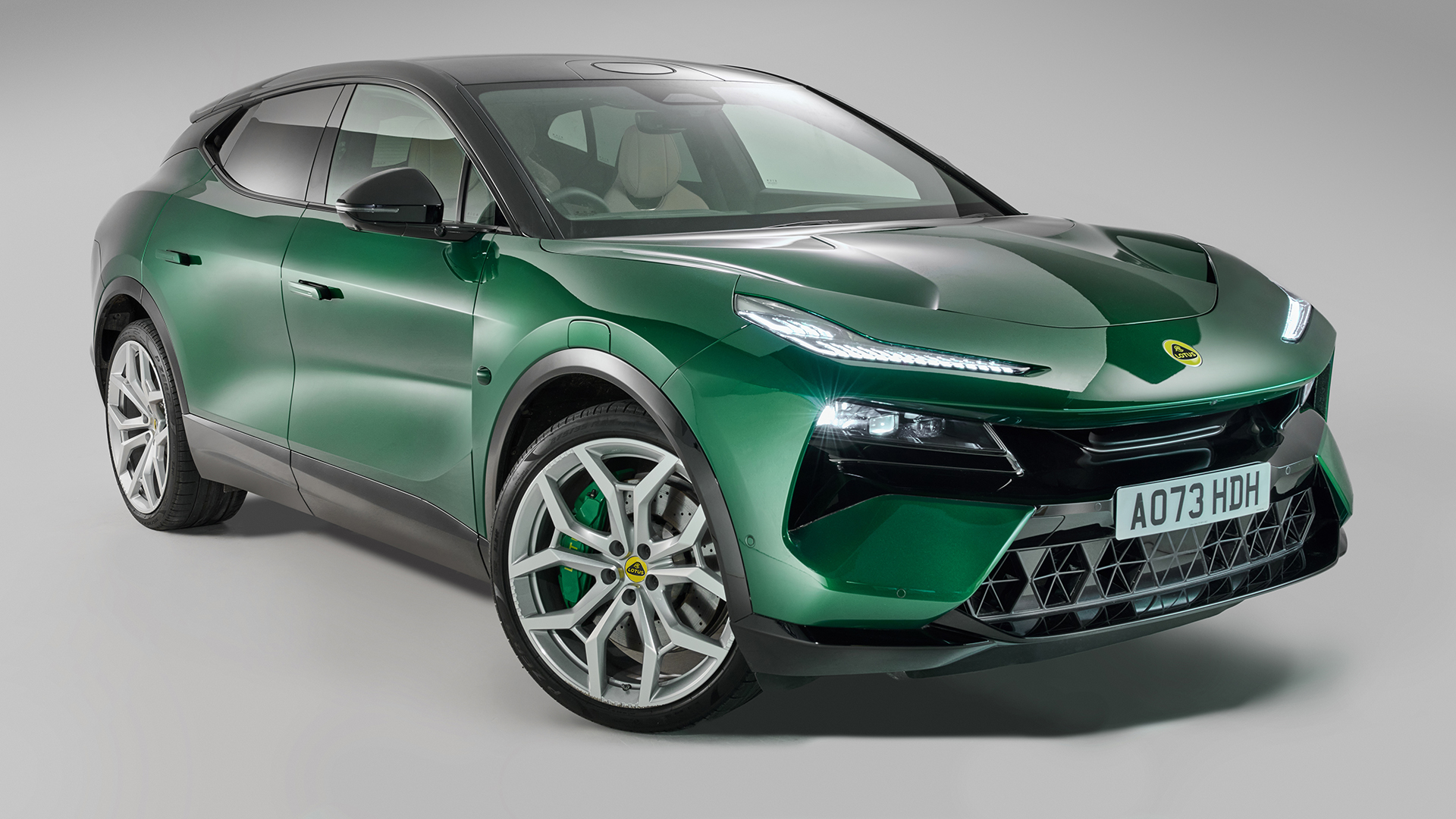
Lotus' all-electric SUV packs in the tech but still delivers that classic sports car styling and performance. It's a big brash statement car that oozes luxury out of every pore and promises future autonomous capabilities. The OS is still a work in progress though.
-
+
Beautifully designed inside and out
-
+
Impressive performance
-
+
Comfortable range
-
-
The OS still needs work
-
-
Certainly on the large side
Why you can trust T3

The Lotus Eletre is the first SUV model from the company and one of a handful of new all-electric vehicles from the now Geely-owned company. The Chinese firm Geely is also the parent company of Volvo, Polestar and Zeekr, so Lotus is in good company here.
Described as a hyper-SUV, the Eletre brings some of that Lotus styling and performance into a significantly larger vehicle. It also brings the company bang up to date with some of the most advanced driving technology on board.
So what is this new generation of Lotus like to drive? I spent a week with the Eletre to really experience how the car drives and what it’s like to live with.
How much does the Lotus Eletre cost?
The Lotus Eletre is available in three main versions. The base model will start from £89,500 in the UK or around $115,000 in the US (expected), with the Eletre S as a mid-range option and the Eletre R as the top model, topping out around £120,000 ($155,000).
You can currently pre-order the car in the US, while here in the UK, there have been models available since mid to late 2023. The Lotus website allows you to fully customise your vehicle and even order the car online.
The model I tested was the Lotus Eletre S, in Galloway Green with a tan and black Nappa leather interior, the executive seat pack, side cameras, glass roof and all the driving aids. This has an on-the-road price of £122,103.
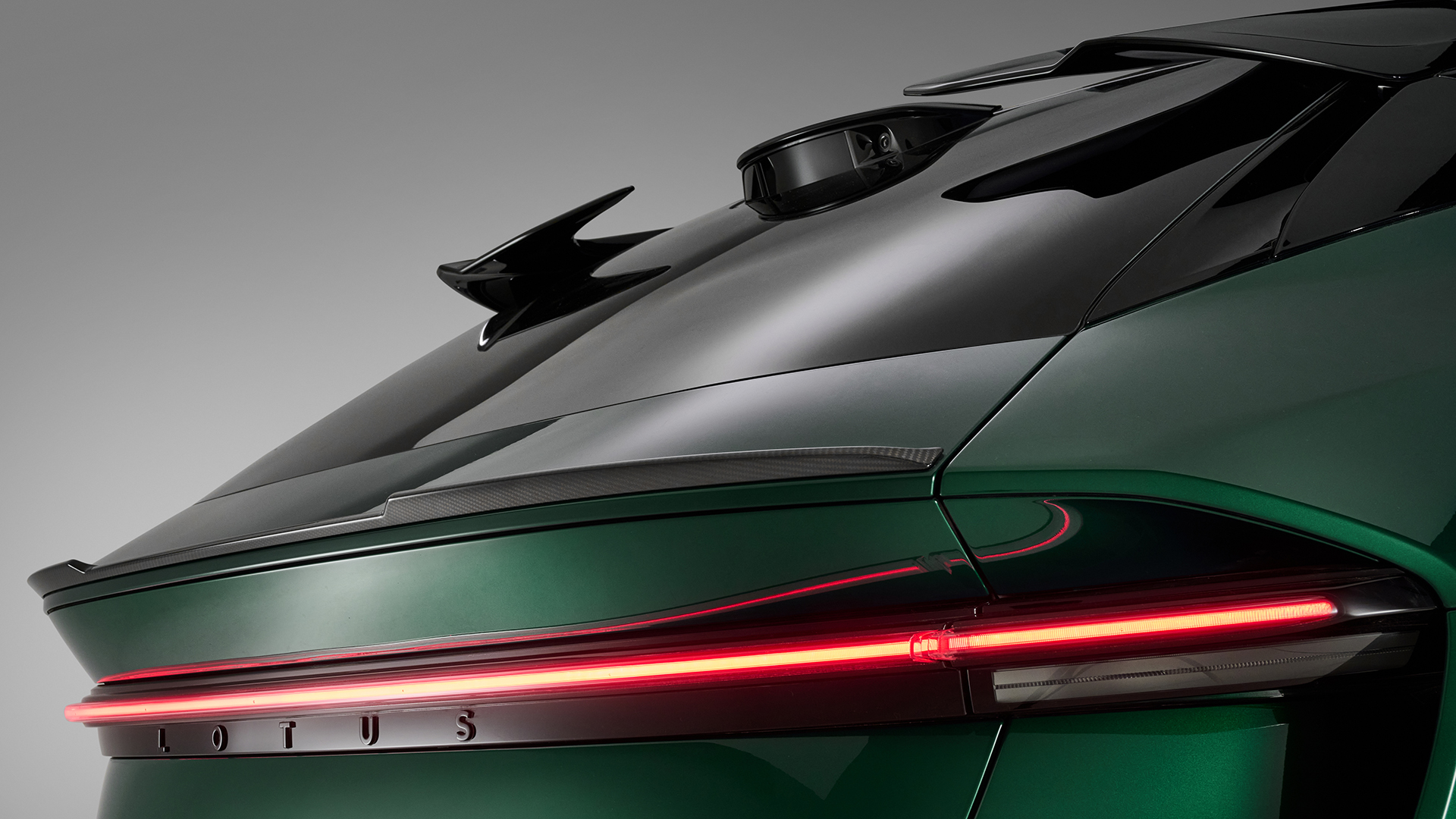
What makes the Eletre unique?
First of all let’s talk about the size of this car, because it’s not just SUV big, it’s really big. At just over 5.1 metres long and 2.2 metres wide, it’s considerably larger than a Range Rover or BMW iX. It’s a similar size to a Mercedes EQS SUV but somehow feels more imposing due to the design.
The front of the Eletre is perhaps the most impressive, with a hard flat nose that is reminiscent of an old Esprit or an Elise. It’s a design feature that is carried across all of the new electric models, from the £2m Evija supercar to the Eletre and Emiya.
Thin and slightly mean-looking daytime running LEDs sit above an open mouth of a black grill, with a jutted-out front spoiler below with automatic shutter that open to cool the motor when needed. There are sharp lines and air curtains everywhere, channelling the air around the car and making this hunk of metal more aerodynamic.
The rear is almost as impressive, with two giant aquatic fins, folded in towards the rear window, a giant housing for the sensors and camera up top and a long red LED strip all the way across the back. There’s also a rear spoiler that automatically raises to increase the downforce at high speed.
Another feature that makes the Eletre so imposing is the giant wheels. While it does come with 20 or 22-inch alloys as standard, my test car was fitted with 23-inch multi-spoke silver alloys and low-profile tyres, revealing those giant Lotus brake callipers underneath.
If you look closely, you’ll also notice that there’s no shortage of cameras and sensors all over the Eletre. From the nose to the wing mirrors and the pop-up LiDar sensor in the roof, they are subtly placed to make sure every area of the road and car is covered.
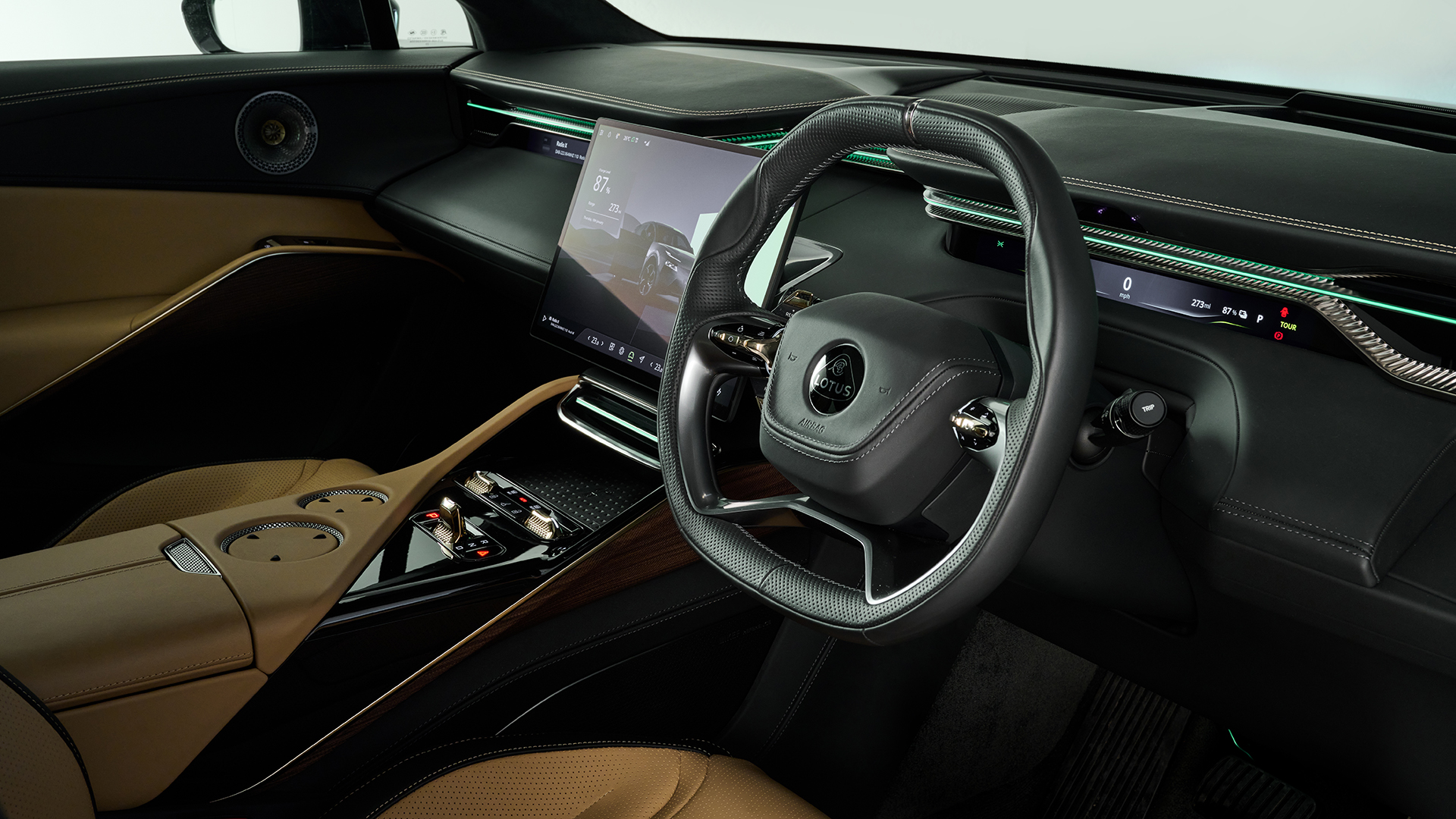
Inside the Lotus Eletre
Inside the car is no less impressive. A thin 12-inch display appears to run from behind the steering wheel, all the way over to the passenger side, displaying both driving information for the driver and media playing for the passenger. These are two separate displays, but the effect is well carried out. In the centre is a generous 15.1-inch OLED display mounted horizontally, which is the way almost all controls are managed.
The centre console houses only a short drive lever, two climate levers and a couple of extra buttons for locking the doors and the rear screen. Even the steering wheel is quite minimal with its buttons, offering the adaptive cruise control and speed limiter functions on the left and the volume on the right. For everything else, there’s the screen or voice control.
This leaves the large dash looking very spacious and modern. Combined with the squared-off steering wheel, it feels more spaceship than sports car, and the elevated ride height allows you to survey the road ahead clearly, despite the deep dash in front of you.
It’s not just the dash that’s luxury though, the trimming is extremely high-end, with Nappa leather draped over every surface. The headrests front and back are embroidered with the four initials of the Lotus founder.
While the back seats are a standard three-seater bench as standard, the Executive option, which I had in the test car, splits them into two seats with a permanent centre armrest that includes its own display screen for controlling the climate and seating in the rear.
There’s also a full panoramic smart glass roof that can be darkened or lightened at the touch of a button to really open up the already spacious cabin. Overall, this is an extremely comfortable and premium space that you’d be happy to spend a lot of time in.

Eletre tech
The Lotus Eletre is packed with technology. On the outside, it combines a total of 34 sensors, including seven cameras that can give a full 360-degree view around the car, six radar, 12 ultrasonic sensors and four deployable LiDar sensors. These rise out of the bodywork – two on the roof and one on each front wheel arch – when required for autonomous driving functions.
Right now, in the UK, the LiDar allows the car level 2 autonomous driving, with acceleration, braking and lane centring but still requires eyes on and hands on the wheel. However, the system will allow the car to operate in a level 3 autonomy, providing up to 124 miles of hands-off operation. In the future, this LiDar could offer full level 4 operation (hands off and eyes off the road).
On the centre screen, the ability of the sensors is shown in a graphic format with all vehicles and pedestrians in the proximity of the car shown. This is surprisingly accurate and can detect people walking around at quite a distance. It’s not perfect though, and sometimes it would think bikes were pedestrians and on the motorway, occasionally mis-positioned cars and lorries when the weather was bad.
The lane centring, while good, didn’t seem any better than some non-LiDar systems I have tried and did need regular input when it lost the road markings. This is something that will improve over time though with over-the-air updates. As is required of all new cars, it does automatically turn on the ADAS (speed and lane) warnings each time the car starts, which can lead to a cacophony of beeps and bings until you find the off switch in the menu.
The Lotus operating system looks very slick and includes a decent mapping system and an array of menus. The ability to spin the car around and click on functions is quite cool too. What may come as a surprise to many buyers is that the operating system currently doesn’t support Apple CarPlay or Android Auto mirroring. That means that you need to use its own apps and navigation – which aside from the automatic charging additions to the route, isn’t as good as Apple’s and Google’s options.
This functionality is said to be coming in the future as an over-the-air update but it’s strange that it’s still not available when the car has been on sale for a number of months. There are other tell-tale signs that the work on the OS is still ongoing. On my model, the DAB radio often failed to scan when losing signal and when the parking cameras were selected, the screen completely locked up until they went off. I’d be surprised if this wasn’t solved by the time this review came out though.
How does it drive?
One thing you can’t fault the Eletre for is its performance. Even the base model gives you 603hp and a 0-62mph acceleration of 4.5 seconds. If you go for the Eletre R you get 905hp and a 2.95 second 0-62mph. That’s a huge amount of power and acceleration.
For such a big car it also handles extremely well. That Lotus DNA has certainly come into play in making the Eletre perform like a much smaller and sportier model. Throw it hard into a corner though and you will still be aware of the weight.
Within the drive modes, there’s a choice of Tour, Range, Off-Road, Individual and Sport (plus Track in the R model). The Tour mode is your standard drive setting and feels pretty responsive, though when switched to Sport, everything tightens up a bit, including the driver’s seat, which brings the sides into your body to hold you in place better.
For longer journeys, the Eletre provides a smooth and comfortable drive, even on the low-profile 23-inch wheel. This really is a car that you would happily spend many hours in, whether that’s as the driver, in the passenger seat or in one of the ultra-luxury rear seats.
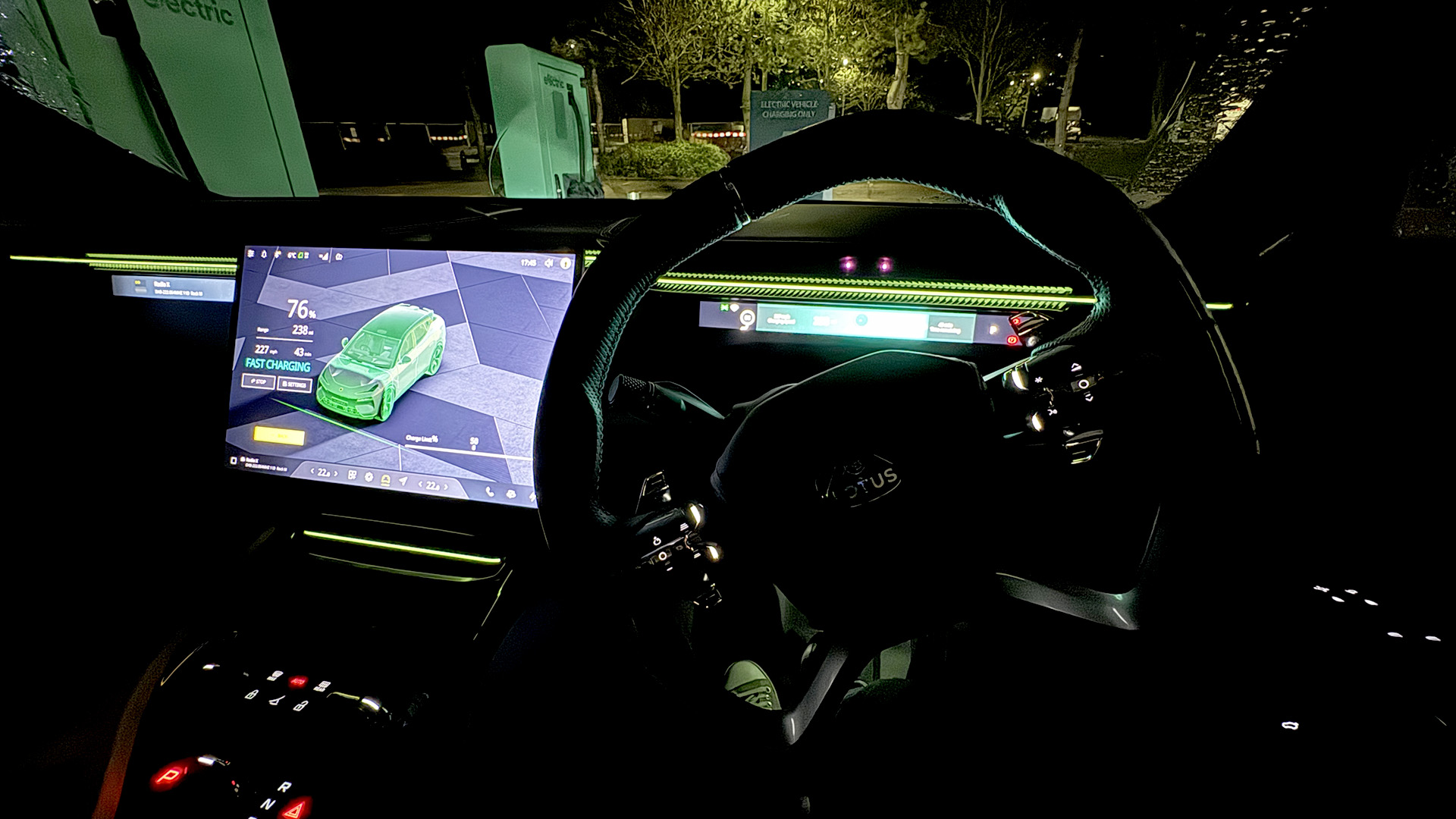
Range and charging
It was a relief to see that the Eletre hasn’t skipped on the battery and charging elements of this car. It features a massive 112kWh battery which delivers a range of up to 373 miles on the base model. This is reduced to 354 on the Eletre S and 280 miles on the Eletre R due to the sheer performance of these models, but the standard and S at least represent a decent long-range option. On my test model (Eletre S) I was still getting around 300 miles of range in harsh winter weather.
Charging is great too. The car uses 800 Volt architecture which allows up to 350kW charging speeds for DC fast charging and 22kW for home AC charging. That’s ideal if you have a three-phase fast charger at home or the office, as it will be significantly faster than the regular 7kW overnight chargers.
Should I buy a Lotus Eletre?
While the premium electric SUV market is becoming a crowded one, the Lotus Eletre does well to stand out in the market. The design is unique and interesting, both inside and out and the amount of technology on offer here is simply breathtaking.
Some may struggle with the disconnect between the small Lotus models of old and the big tech-heavy machine but the Eletre retains a lot of that Lotus DNA, both in looks and in performance. Even the standard and S models feel hugely powerful and handle exceptionally well on the road, while the R is one of the quickest in its category.
The biggest competition for the Eletre is perhaps not existing models like the BMW iX and the Jaguar I-Pace, but new additions such as the forth-coming Porsche Macan Electric and the Range Rover Electric. While the Lotus outperforms the Macan, it's also more expensive and the Porsche is running on a version of Android Automotive. So, while Lotus lists some incredible driving features, the OS feels a little less polished than the competition.
With over-air-updates, the OS is ever-evolving on modern cars, and everything else here it absolutely top drawer. If you really want an EV that stands out and delivers both luxury and performance, the Lotus Eletre should be on your shortlist.
Sign up to the T3 newsletter for smarter living straight to your inbox
Get all the latest news, reviews, deals and buying guides on gorgeous tech, home and active products from the T3 experts
As T3's Editor-in-Chief, Mat Gallagher has his finger on the pulse for the latest advances in technology. He has written about technology since 2003 and after stints in Beijing, Hong Kong and Chicago is now based in the UK. He’s a true lover of gadgets, but especially anything that involves cameras, Apple, electric cars, musical instruments or travel.
-
 Gossamer Gear's Grit 28 is a masterclass in ultralight backpack design
Gossamer Gear's Grit 28 is a masterclass in ultralight backpack designTrail runners and fastpackers, take note
By Matt Kollat Published
-
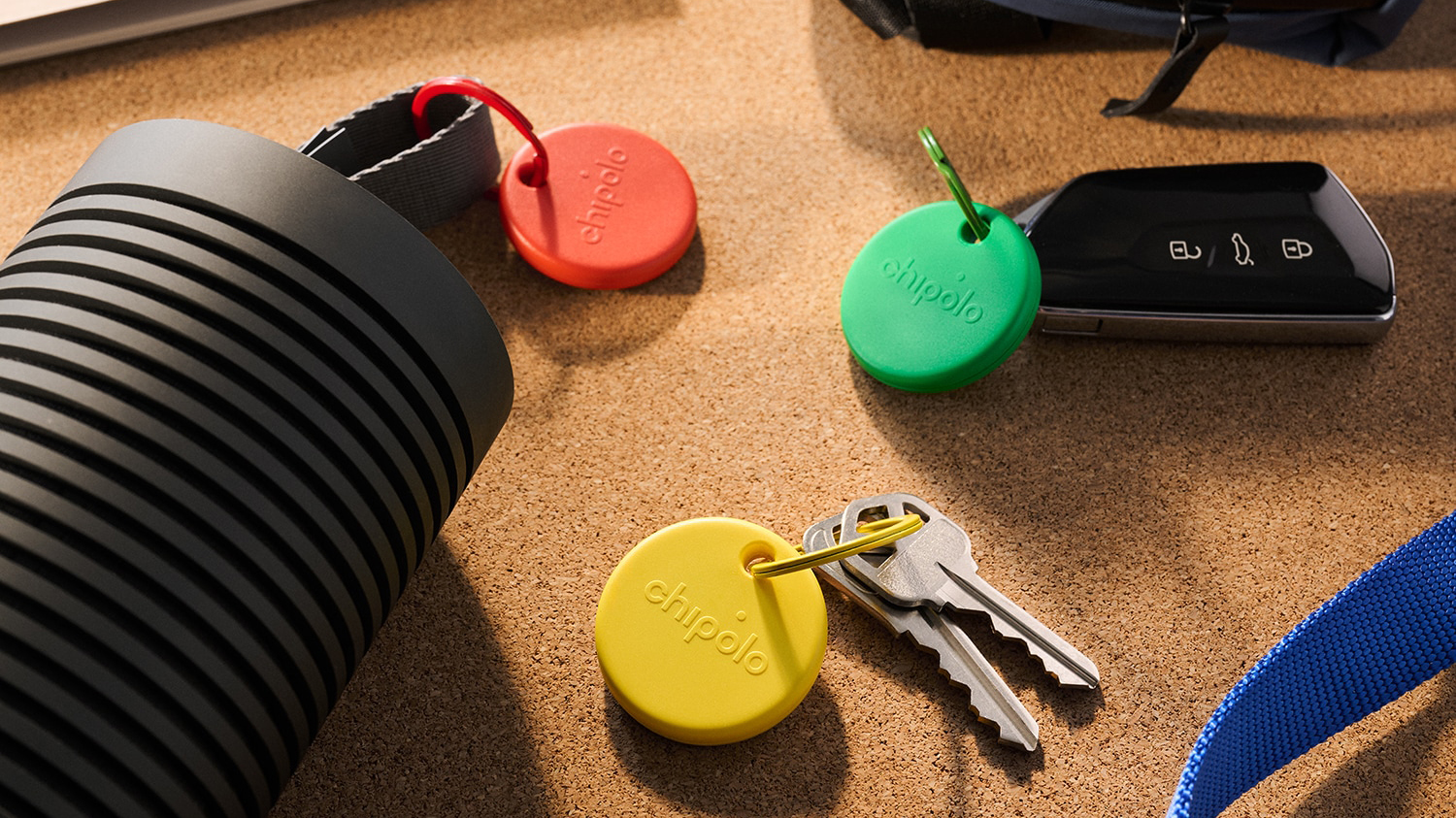 Forget AirTag, Chipolo's new Bluetooth tracker adds a dash of colour
Forget AirTag, Chipolo's new Bluetooth tracker adds a dash of colourChipolo's Pop tracker works with both Apple's Find My and Google's Find My Device – so you can track whichever platform you're using
By Mike Lowe Published
-
 The 5 luxury PS5 Pro accessories I can't live without – How to upgrade your PlayStation in style
The 5 luxury PS5 Pro accessories I can't live without – How to upgrade your PlayStation in styleIf you want a better experience for your PS5 Pro, you need these luxury upgrades
By Max Freeman-Mills Published